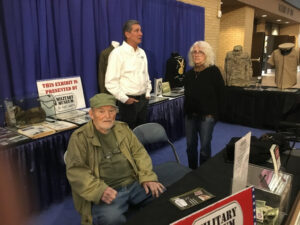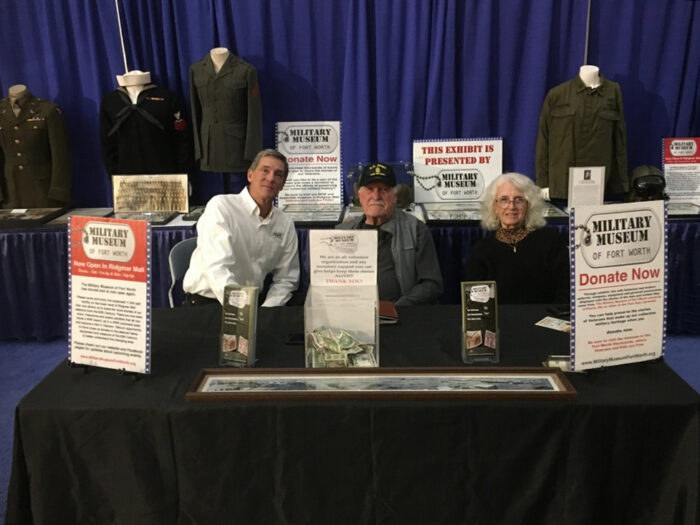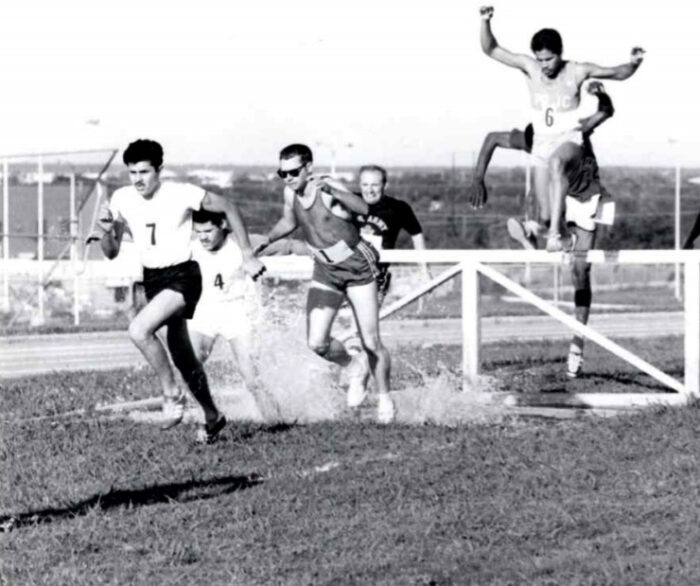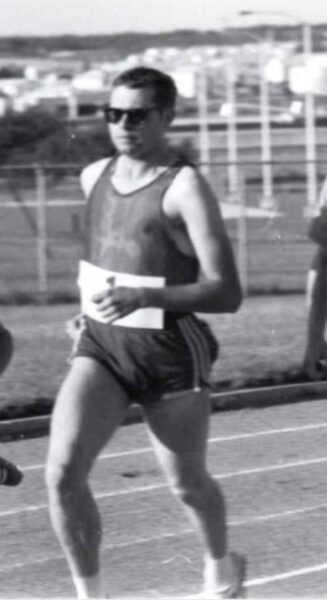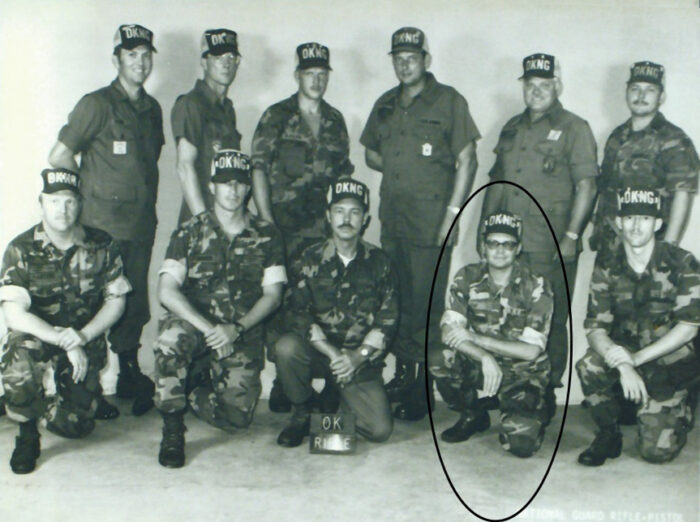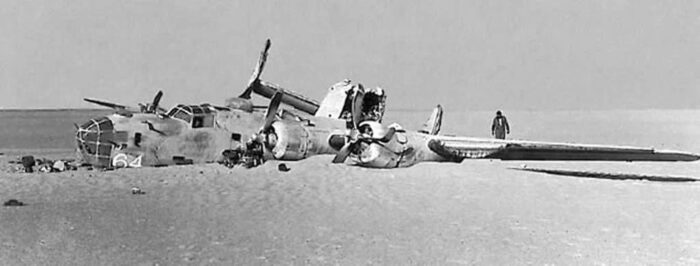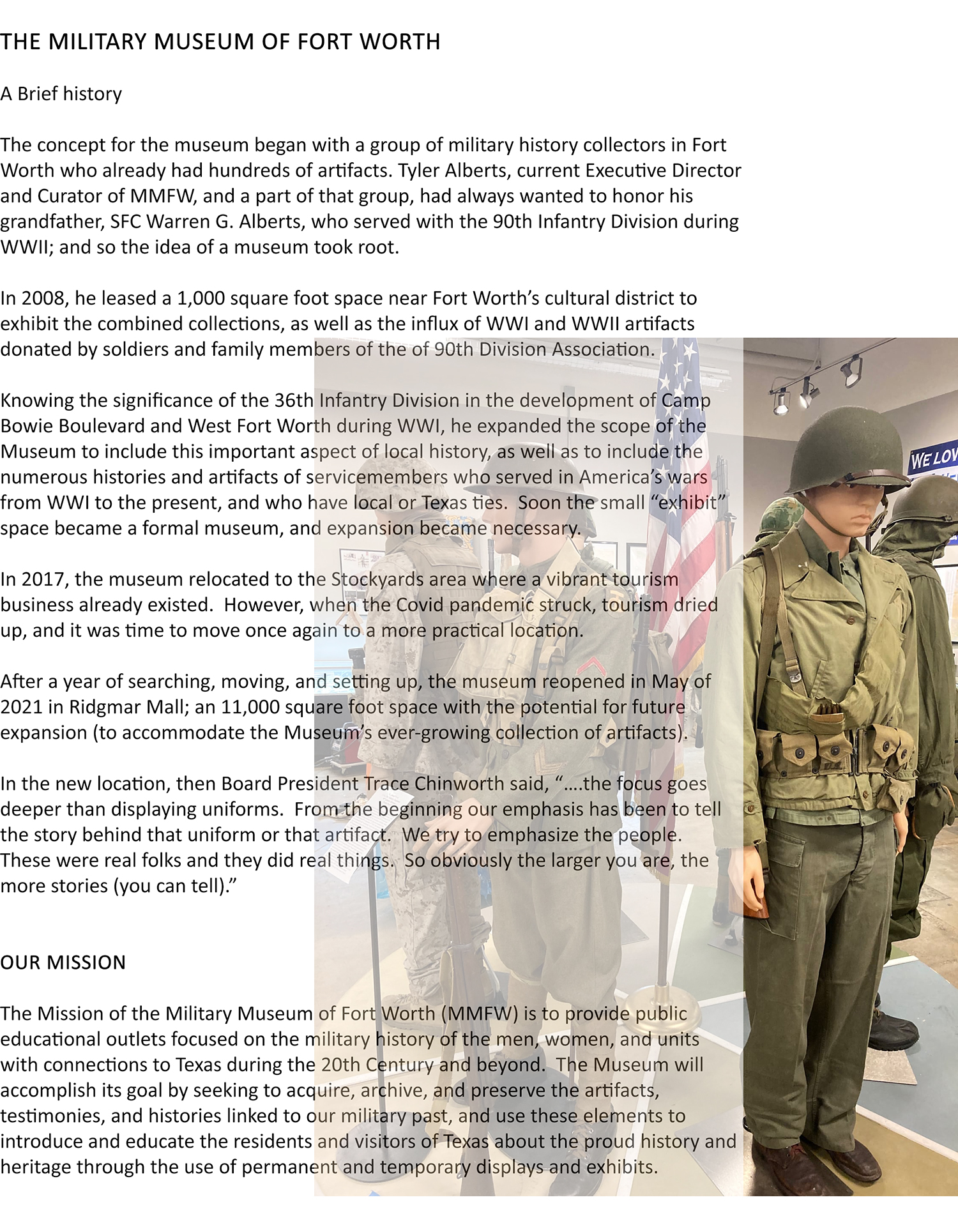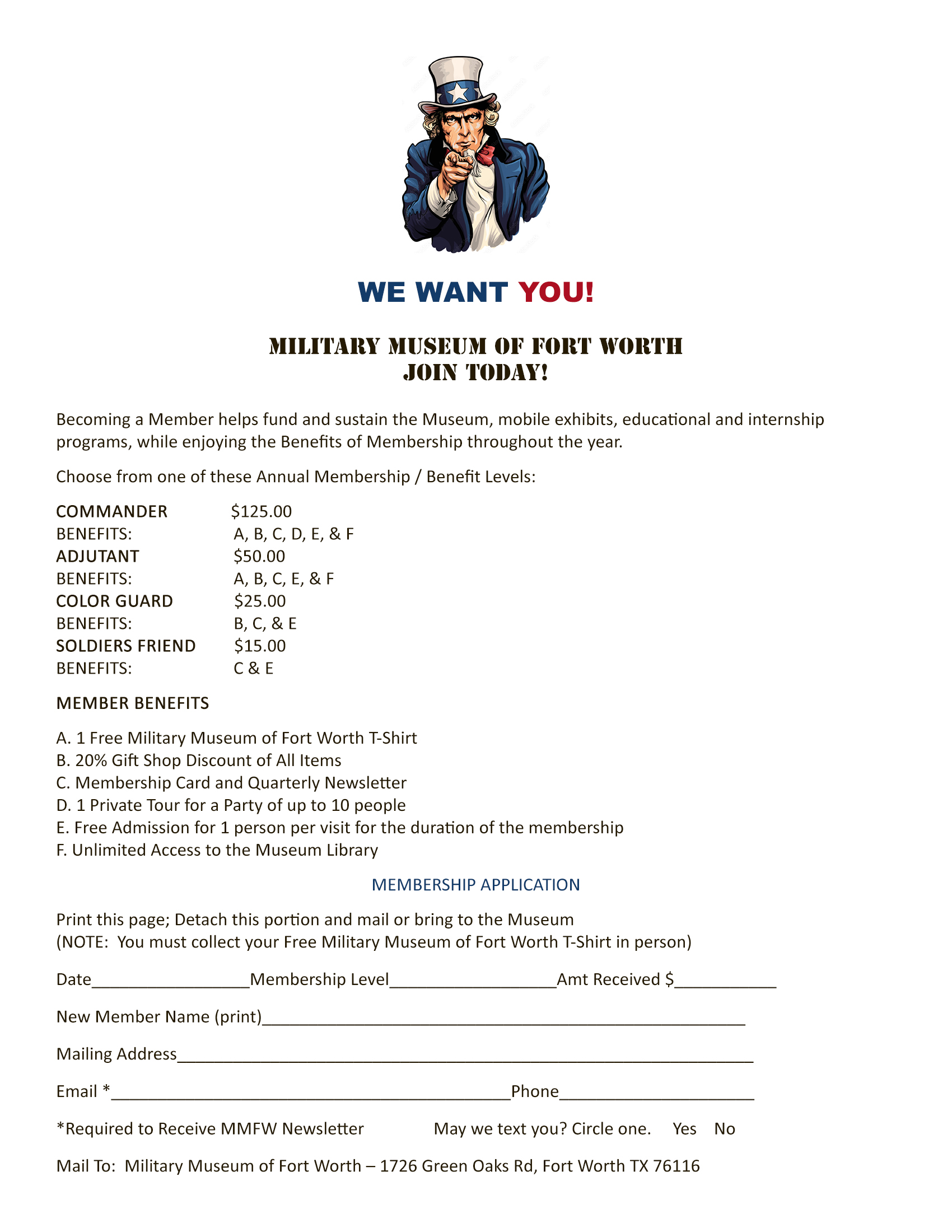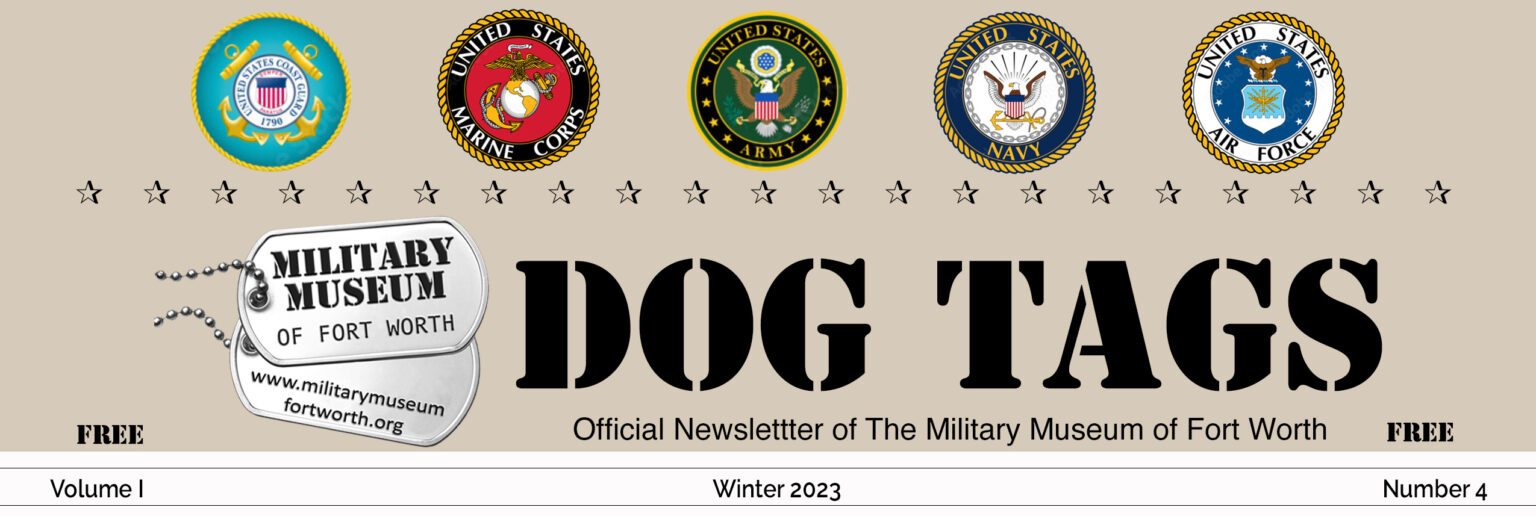
SIT REP (Situation Report)
Rodger W Brownlee
Hope this Winter edition of Dog Tags finds everyone in a comfortable place, snug, safe, and warm. It’s that time of year when you can kick back before the fireplace with a warm drink, a good book (or this Newsletter), pet the dog (or cat), and catch up on your reading. Contrary to popular belief, it can and does get cold and nasty in Texas, sometimes.
Have all of you made your lists of New Year’s Resolutions; I have? Some folks believe it’s a waste of time, and that may be the case for many. But at my age, I live by lists; of what I’m going (or need) to do tomorrow, next week, and next month. Idle time is wasted time, and even the smallest accomplishment is a victory and a step forward. For me, since I have more to do in retirement than I ever imagined, it’s not unreasonable to organize my time and plan ahead for the coming year. I’ve already made my list of personal goals, and thought it would be a good idea to come up with a few for the Museum as well, priorities if you will, and here they are. (1) recruit sustainment doners; (2) recruit more (and younger) volunteers; (3) increase outreach to include more senior communities (4) increase our Membership base. There, four simple goals, all reasonable and attainable with liberal applications of elbow grease. So, make your own lists, check them twice (throw in a few for the Museum), and start checking them off; you’ll feel better for it.
This past year the Museum was recognized for certain of its activities and accomplishments. Among the more notable was coming in First Place in the Museum category in the annual “Fort Worth Favorites” survey determined by on-line voting. Another was our Curator, Tyler Alberts being presented with an award by the County Historical Commission recognizing his work for bringing attention to the historical aspects of Camp Bowie Blvd. and the west side of Fort Worth. MMFW also gained exposure and notoriety for our participation in the local Veteran’s Day Parade; providing our mobile displays at various locations for Veteran’s Day functions; for the excellent in-house diorama created by Bill Leaf to commemorate Dec. 7, Pearl Harbor Day, and more recently our table and display at the Amon Carter Exhibit Hall at the Fort Worth Stock Show and Rodeo.
The Stock Show event was a five-day set-up for MMFW in a prime, 30 foot, indoor location next to the Roundup Inn; and as Johnny K. so aptly remarked, “…Tyler did a lovely job setting up the exhibit…” with a sampling of all the wars represented in the Museum itself, and there “…seemed to be more traffic than ever!!”. He was right, and the great thing about the Fort Worth Stock Show and Rodeo is that there are “Cowboys” from all over the country in attendance, many of whom are also veterans. I personally spoke with visitors from as far away as New York and Connecticut, who expressed great interest in the museum and the work that we do. All in all, it proved to be an excellent public relations event, and provided great exposure for the Museum.
Kudos to all our Board Members and Volunteers who juggled their time and schedules to enable us to successfully operate these events and the museum simultaneously. It’s a lot of hard, but rewarding, work.
Also during the past year Tyler has practically doubled our exhibit square footage with the use of display cases generously donated by the Kimbell Art Museum; the donation of artifacts just keep coming in; and we have also taken positive steps toward making our M3 Stuart tank and White Halftrack ready for display, and ultimately operable.
SIT REP CONT.
All in all, 2023 was a busy and successful year for the Museum, and we look forward with anticipation to an even more successful, prosperous year in 2024.
I think it was the line, “…tis The Winter of our Discontent…” in Shakespear’s Richard III, that set the tone for Winter being a time of boredom, depression, and inactivity. Seems old Richard was having a hard time and had a bad case of the Wintertime Blues. But that doesn’t have to be the case; there are plenty of activities that can occupy one’s time; like sitting before the fireplace, catching up on your reading / research, or even better, going out to a good Military Museum (we just happen to know one).
For the military enthusiast, Winter conjures up images and stories of some of the more significant events and campaigns in military history; Hannibal crossing the Alps, Napolean’s retreat from Moscow, the Continental Army at Valley Forge; and in the modern era, Stalingrad, the Battle of the Bulge, and the Chosin Reservoir; all events in which the individual soldier endured unimaginable hardships while attempting to do his duty and carry out the mission. In the process, these individuals unintentionally created tales of heroic effort and endurance that have become the stuff of military legend.
It’s this human drama, the trials and tribulations of the individual soldier that tells the true story of these events, and that can often only be told and reimagined from the artifacts, uniforms, letters, and souvenirs they leave behind. Viewing these items, with the help of the imagination, the soldier and his story comes to life.
When you see that WWI uniform, or that WWII helmet, or the medals and stacks of letters, that’s when our imaginations go to work, as we’re reminded that these items were worn by or belonged to real people just like us, who answered the call and made the sacrifices. And that’s the very essence of the Military Museum of Fort Worth; it’s more than just a repository for military artifacts, it’s a reminder, a Memorial if you will; not only to those whose artifacts are on display, but also to the millions of individuals those artifacts represent. It triggers the newsreels of our mind to those images of people, places, and things we should never forget.
Hope to see you soon at Military Museum of Fort Worth
SPECIAL NOTE! MMFW Board Member, Ron Lane, USAAF Major- retired, celebrated his 85th birthday, February 10, at Fred’s Café surrounded by fellow board members and friends.
HAPPY BIRTHDAY, RON!
Out Here
| Tyler Alberts | Co-Founder/Executive Director |
| Rodger W Brownlee | President/Newsletter Editor |
| John Kalvelege | Vice-President Director |
| Karen Garrison | Media and Communications Director |
| Trace Chinworth | Director Outreach Education |
| John T. Furlow | Treasurer |
| Mike Zamulinski | Secretary/Outreach Director |
| Bill Leaf | Special Projects/Board Member |
| Ron Lane | Board Member |
| Stacey Sokulski | Board Member |
| Dale Wagner | Board Member |
| VOLUNTEERS | |
| Paul Fraga | Gift Shop Manager |
| Colin Fish | Volunteer |
| James Warner | Volunteer |
Board Member Spotlight
Rodger W Brownlee
Major William Leaf Jr, Infantry, retired
William Leaf Jr. was born at Madigan Army Hospital, Fortt Lewis, Washington in 1954. His mother took him back to Muskegon, Michigan where his Father joined them after his discharge from the Army. They soon moved to South Bend, Indiana where Bill attended St. Joesph’s High School. He spent a year at IIT in Chicago, then a year at SMC (JC) in Dowagiac, Michigan where he was on the track team. Bill was training for the National JC Marathon when a foot injury stopped him. His family had moved to Oklahoma City, Oklahoma, where he joined them and attended Central State University in Edmond, Oklahoma as part of the ROTC program. He ran track for a year and had the school record for the 3000m Steeplechase that year.
He received a reserve commission as an Infantry 2 LT in 1979, and a BS in Education. After Infantry Officer’s Basic Course, he was assigned to 2nd Bn 41st Infantry Regt 2nd Armored Division as a Platoon Leader. After a year he was moved to HHC XO and took part in Reforger ‘80. Bill was then moved to 1st (Tiger) Brigade HQ and took over Burba Gym and the recreational athletics program for the Brigade. During this time Bill took part in several running events and was the 1981 III Corps and Fort Hood Champion in the 3000m Steeplechase during the III Corps Track meet.
In 1982 Bill completed his 3-year active tour and moved back to Oklahoma City, OK. He joined the 2nd Bn 180th Infantry TLAT (Tow Light Anti-Tank) of the Oklahoma National Guard. At first, he was overstrength in the BN HQ, then Platoon Leader in C co. Finally, he was selected as HHD Commander and promoted to Captain. Since the TLAT Battalions were designed to attach out their Companies to support other units, they did not have a full Bn staff, only Personnel (S-1), Operations (S-3) and Supply (S-4) shops.
Bill started wargaming with Avalon Hills “Blitzkrieg” in the late 60s, before moving on to miniature battles. Wanting to get organization and tactics correct for the Armies he built and fought, Bill did extensive research. Of particular interest were the Soviet Union and Warsaw Pact Forces. Since 2nd 180th did not have an S2 (Intelligence) position, Bill filled in at that position creating briefings for the Companies, both while at home stations, during field exercises, and Annual Training. During one Drill at Camp Gruber where 2 companies were exercising, Bill brought his 1/72 scale models and using the parking area of an unused range, set up a Soviet Motorized Rifle Battalion in a movement to contact formation. The platoons would bring their vehicles to the line and use the TOW sights and Binoculars to spot the Soviet models at a scale distance of 3000 meters. The lead Soviet companies were arrayed according to Soviet Doctrine; Scout cars, tanks, APCs, and Air Defense vehicles were all positioned as they would likely be on a battlefield. Closer to the platoon were US and NATO vehicles in the defense. After all of the crew members rotated through the sights and Binos, Bill took them on a walk through of the area, pointing out how the Soviet units were organized and deployed. Not only did the TOW crews get training on vehicle ID, but where to look for the other vehicles in a Soviet Platoon, Company, etc.
During his time as HHD Commander, he was also a member of the OKNG High-power Rifle Team. He made 2 trips to the Wilson Matches (NG National Championships), 1 to the 1986 5th Army Reserve Component Championship matches and a trip to Hawaii to compete in a Rifle match sponsored by the Marines. He also made the Governor’s Twenty during the Oklahoma State NG matches.
Board Member Spotlight Cont.
During his 2nd year as HHD Commander, Bill was sent to the Infantry Officer Advanced Course at Fort Benning, Georgia. During a chance meeting with the Brigadier General Commanding the 45th Inf Bde, he was told that he was considered the Oklahoma Army National Guard’s resident expert on the Soviet Union and Warsaw Pact Forces. Bill graduated IOAC on the Commandants list.
After two years as HHD Commander Bill moved on to HHC 1/179th Inf as overstrength S3 (Operations). For Annual Training, his unit went to Camp Ripley, Minnesota for Winter Warfare training and school. After a year with this unit, Bill moved to the IRR for several years.
During this time, he traveled to Norfolk, Virginia, several times to act as the “aggressor” during the Joint Staff College Graduation wargames. He also spent two weeks at Fort Jackson, South Carolina where he reviewed and upgraded various plans including the NBC Contingency Plans. He was promoted to Major during this time. He spent another 2 weeks with III Corps in Fort Lewis, Washington where he consolidated the various documents dealing with the Warfighter 21 program. He then joined the 4155th RTU in Oklahoma City for a few years where he helped with the small museum at one of the 95th Training Division’s armories.
In 1997 he joined the 2nd SEG (Simulation Exercise Group) 1st Brigade (Bde), 75th Training Division at Ft Sill, OK. Because of his experience and subject-matter expertise, Bill was usually tasked with creating the OPFOR (Opposing Forces) script for the computer aided exercises. For the 45th Field Artillery Bde exercise, Bill not only created the script for the OPFOR, he also set up an impressive Rock Drill using cardboard to give the impression of the relief in Korea, and with the help of the Task Force NCOs, used Flags on Styrofoam blocks to show the planned movement of both friendly and OPFOR forces during the exercise.
Having obtained his Teaching Certificate in PE after his active-duty time, Bill discovered there were few PE openings in Oklahoma. He spent several years as a substitute in the Oklahoma City area while going back to school for Elementary Education, Social Studies, and Science.
In 1998 he obtained his Texas Teaching Certificates in Social Studies and Science, and moved to Mesquite, Texas to teach in Wilmer Hutchins Middle School. The following year he moved to Springtown, Texas teaching Chemistry, and finally to Fort Worth's Northside High School teaching IPC and Chemistry. He continued there until January 2003 when his reserve unit, the 2nd SEG, was mobilized for Operation Noble Eagle, which provided homeland security after the attacks of 9-11.
The next 6 months were spent moving from Fortt Carson, Colorado, to Fort Hood, TX, to Fort Sill, Oklahome, where he taught mobilizing units the process and procedures for writing Operations Orders (OPORDS). The SEG demobilized from active duty in July 2003, and Bill retired from the Army Reserves.
He spent 1 more year at Fort Worth's Morningside Middle School, then spent a year substituting before working as a Special Education Aide at Lake Worth High School. Next was 5 years at Everman High School teaching Science. Then 2 years as a substitute before spending 5 1/2years teaching Science at Richard Milburn Academy .
Retiring from teaching after the Covid lockdown was lifted, he went back to substituting to keep from driving his wife crazy.
Re-discovering the Military Museum of Fort Worth after having visited it at its first location on Dorothy Lane and later in the Stockyards, Bill talked museum curator Tyler Alberts into letting him set up the evolution of tanks exhibit. After multiple visits Tyler “drafted” him as a volunteer, which has helped keep him from going crazy. Bill is responsible for any of the 3D Printed items in the museum, from the lightweight pistols on the mannequins to the small ships, tanks and planes in the exhibits. The 3D printed Pearl Harbor exhibit was Bill’s most recent undertaking. He hopes soon to have this exhibit ready to travel to schools and libraries as a mobile display.
Among his other achievements, Bill helped bring the Cowtown Showdown Wargaming tournament to the Museum. He has produced numerous terrains and scenarios for wargames, both on cloth, and more recently 3D using Styrofoam.
Bill oversaw the first organization of the Museum library, and also created the “Patch Wall”; an impressive collection of Military patches of all branches.
He also thought up and produced the NERF gun range, a very popular attraction for adults and kids alike. He plans to include the NERF guns on the jeep and halftrack for use at events like Wings Over Dallas or Hops and Props.
Bill lives in Sansom Park with his wife Jackie.
EDITORS NOTE: I call William “Bill” Leaf our Special Projects “Guru”. With his skill, knowledge, and expertise, he has created and added-to many of the displays and exhibits in the Museum; often creating many of them from scratch.
Bill Volunteers to run the Museum, and when not attending to other responsibilities outside the Museum, you can often find him there on any given day, hard at work to make the museum more attractive to its many visitors. And last but not least, Bill has served for many years on the Museum’s Board of Directors, always providing valuable input. Military Museum of Fort Worth is indeed fortunate to have him as part of the Museum Family.
Lady Be Good
DALE WAGNER
Among the various artifacts that the Military Museum of Fort Worth has on display, there is one that many people may overlook, tucked away as it is in a case behind the large, cutaway B-36 Bomber engine. The artifact is also part of an aircraft engine; how it came to the museum, I will leave for others to tell, and instead I will tell the story of the aircraft it came from and its crew.
At 2:50 p.m. on April 4, 1943, 25 B-24Ds of the 514th Bomb Squadron of the United States Army Air Forces (USAAF), itself part of the 376th Bombardment Group (Heavy), took off from their base at Soluch Field, near Benghazi, Libya, in North Africa. Their mission was to conduct a high-altitude bombing attack against harbor facilities at Naples, Italy. When the mission concluded, all aircraft save one, returned safely to their base that night. Missing was the Lady Be Good, serial number 41-24301. The Lady Be Good was a new aircraft, named after a 1941 movie (and title song of the same name *). Its nine-man crew, also new and inexperienced, was on its first combat mission. The members of the crew were:
- 1st Lt. William J. Hatton, pilot — Whitestone, New York
- 2nd Lt. Robert F. Toner, copilot — North Attleborough, Massachusetts
- 2nd Lt. DP Hays, navigator — Lee's Summit, Missouri
- 2nd Lt. John S. Woravka, bombardier — Cleveland, Ohio
- T/Sgt. Harold J. Ripslinger, flight engineer — Saginaw, Michigan
- T/Sgt. Robert E. LaMotte, radio operator — Lake Linden, Michigan
- S/Sgt. Guy E. Shelley, gunner — New Cumberland, Pennsylvania
- S/Sgt. Vernon L. Moore, gunner — New Boston, Ohio
- S/Sgt. Samuel E. Adams, gunner — Eureka, Illinois
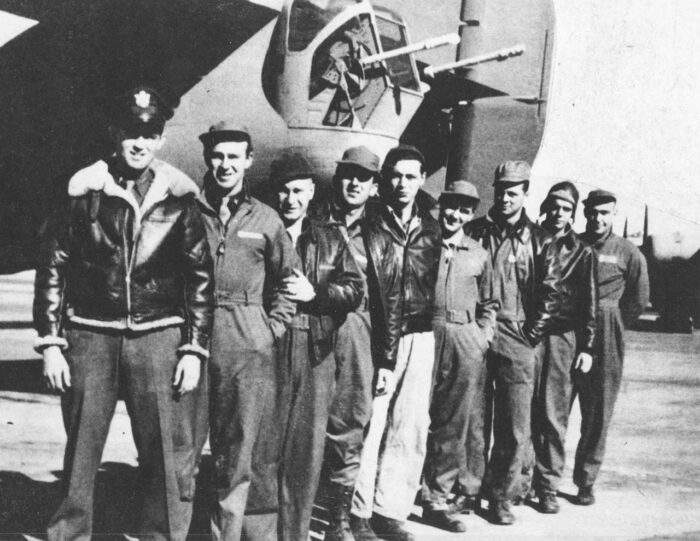
Left to Right: 1lt William Hatton; 2lt Robert Toner; 2lt D.P. Hays; 2lt John Woravka; Tsgt Harold Ripslinger; Tsgt Robert Lamotte; SSG Guy Shelly; SSG Vernon Moore; SSG Samuel Adams
The mission started off well, with the Lady Be Good being one of the last to take off. The plan called for her to catch up with the other aircraft, and once assembled in two waves, the group would fly across the Mediterranean Sea and hit the target. Unfortunately, Sahara winds produced a dust storm causing poor visibility that scattered the planes and forced many of them to abort the mission. Nevertheless, a small number of planes attempted to reach the target, with two of them bombing an alternate target. Short of Naples, the Lady Be Good, aborted, dumped its bomb load into the sea, and turned for home. Flying alone, she was last heard from reporting that her radio direction finder was not operating correctly, and requesting help. Flares were shot up into the night sky but she was never heard from again. A search was conducted, but no sign of her was ever found, and her disappearance remained a mystery when the war ended. The crew was listed as Missing in Action.
In November 1958, British geologists working for an oil company reported seeing a crashed aircraft while flying over the desert. In March 1959, a ground team found the aircraft and reported its location, along with aircraft information and names found on clothing, to officials at Wheelus Air Force Base, near Tripoli, Libya. In May 1959, officials from Wheelus, and the Army Quartermaster Mortuary in Frankfurt, Germany, traveled to the crash site to investigate. What they found was the Lady Be Good in a remarkably well-preserved state. 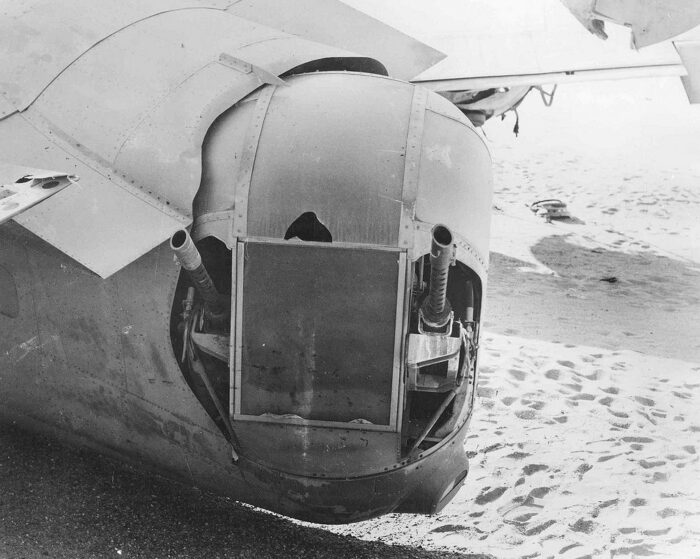 The plane had made a surprisingly good pilotless belly landing, skidding some 700 yards before breaking in half and stopping. Besides being relatively intact, the B-24’s .50 caliber machine guns were still in working order, with the investigators actually firing one of the guns, the aircraft’s radio was still functional, and one of the engines was also found to be in working condition. Three of the engines had been feathered when it crashed, indicating that Lady Be Good had run out of fuel. On board, they found survival equipment and food, all properly stored, and even a thermos of tea, still drinkable. All that was missing was the crew and parachutes, indicating they had bailed out.
The plane had made a surprisingly good pilotless belly landing, skidding some 700 yards before breaking in half and stopping. Besides being relatively intact, the B-24’s .50 caliber machine guns were still in working order, with the investigators actually firing one of the guns, the aircraft’s radio was still functional, and one of the engines was also found to be in working condition. Three of the engines had been feathered when it crashed, indicating that Lady Be Good had run out of fuel. On board, they found survival equipment and food, all properly stored, and even a thermos of tea, still drinkable. All that was missing was the crew and parachutes, indicating they had bailed out.
Parts of the aircraft were salvaged, some to be taken back and tested to see what effect sixteen years of sitting in the desert had done to them; others parts were used to make needed repairs to the investigator’s aircraft, for their return to Wheelus. In August 1959, an extensive ground search was conducted, which turned up some personal effects and random items of crew equipment, but still no human remains or clues to the eventual fate of the missing crewmembers; It was as if they had vanished into thin air. The ground search being completed without result, the investigation was closed down, and the fate of the crew remained listed as MIA.
Lady Be Good Cont.
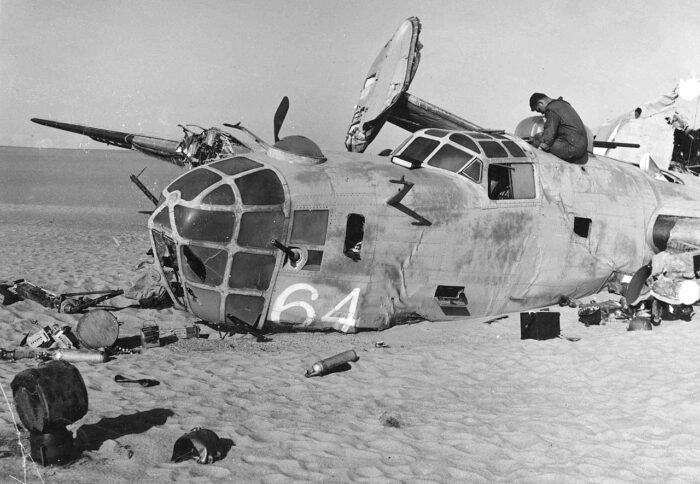 Then in February, 1960, in the same general area, British Petroleum employees came across human remains, and once again Army Mortuary personnel returned to the scene to investigate. What the British Petroleum employees had stumbled across turned out to be remains of five of the missing airmen. Along with more personal items, a diary kept by 2Lt. Robert Toner, was discovered. It told an amazing tale; Lady Be Good had indeed overflown its base in the darkness, and as the plane began running out of fuel, the crew made a decision. Believing they were still over the ocean, they decided to parachute out rather than try to land the plane. Leaving the plane on autopilot, eight of the men made and survived the jump. Once on the ground, firing their pistols and signal flares into the air, they were able to meet up.
Then in February, 1960, in the same general area, British Petroleum employees came across human remains, and once again Army Mortuary personnel returned to the scene to investigate. What the British Petroleum employees had stumbled across turned out to be remains of five of the missing airmen. Along with more personal items, a diary kept by 2Lt. Robert Toner, was discovered. It told an amazing tale; Lady Be Good had indeed overflown its base in the darkness, and as the plane began running out of fuel, the crew made a decision. Believing they were still over the ocean, they decided to parachute out rather than try to land the plane. Leaving the plane on autopilot, eight of the men made and survived the jump. Once on the ground, firing their pistols and signal flares into the air, they were able to meet up.
They took stock of what they had. It was not very much, with only a half canteen of water between them. Investigators determined they were fifteen miles north of the crash site. Had they walked south to the crash site, they would have had food, water and a working radio with which to call for help. Instead, thinking that they were close to the coast and their base, they headed north, not realizing that they were almost 400 miles away. They managed to survive for over eight days in the searing heat. Five of the men walked 85 miles before becoming too exhausted to continue. Three men continued on, trying to find help. T/Sgt Harold Ripslinger had also kept a diary, and although it was in poor condition, it told the same story of hardships endured by the crew on their long walk. His last entry had been “Still struggling to get out of dunes and find water”.
Investigators found the remains of Sgt. Guy Shelley 21 miles north of the main group, and Sgt. Ripslinger’s remains were found another 26 miles further on. In May 1960, the search for the last two men was called off. However, in August, 1960 the remains of 2Lt. John Woravka were found. He had been the only crew member that had not met up with the group after bailing out of the aircraft. Evidence at the scene indicated that his parachute did not fully open, and he likely died on impact. The remains of the ninth airman, Sgt. Vernon Moore, have never been found. However, his remains may have been recovered and buried by a desert patrol of the British Army in 1953. They were unaware that any missing air crews might be in the area, and thus the remains were recorded but then buried without further investigation; this was in the same general area as Shelley and Ripslinger. This information came to light only in 2001, but given the political situation in Libya at the time, no attempt has been made to recover these remains.
Seven of the eight air-crewmen were buried near their home towns, and the eighth was buried at Arlington National Cemetery. At least two books and numerous newspaper and magazine articles have been devoted to this subject. Various items from the Lady Be Good went to the Air Force Museum, Air Force Academy, and the Army Quartermaster Museum. Over the years, souvenirs were also removed from the aircraft by search party members and various oil exploration teams passing through the area.
EDITOR’S NOTE: I first became aware of the story of the Lady Be Good in 1959/60 when as a fourteen-year old, I read a feature story that ran in PARADE Magazine, the Sunday newspaper supplement. Not long after the story ran, it was followed by a television special with newsreels of the Lady Be Good in situ.. At the time, the mystery of the missing aircrew had not been solved, and that missing part of the story captivated and endured in my imagination for many years.
In his article, Dale has captured the essence of the story of the Lady Be Good and its crew, one of the more intriguing MIA stories of WWII. Come see our small part of the story at Military Museum of Fort Worth.
* “…Oh, Sweet and lovely Lady, Be Good. Oh, Lady Be Good to Me. I am so awfully misunderstood, So Lady Be Good to me…..”. This verse is from the popular song that was written by George and Ira Gershwin for the 1924 broadway musical, Lady Be Good. The song remained popular and was recorded by numerous artist, including Count Basie in 1939, 1n 1941, a musical film of the same name was produced, and the song was performed by the chorus.
The song and the lyrics were popular and evocative of the emotions of many young, lonely American servicemen who soon found themselves in the middle of a life-or-death drama far from home, perhaps looking for a chance romantic encounter with that Lady Be Good. It is not surprising that one young American aircrew chose it as the namesake of the ”Lady” they would fly into combat.
THE OLD GUARD BUNCH
Rodger Brownlee
The "Old Guard Bunch" is an informal gathering of military retirees and their significant others who meet from time to time (there is no specific schedule) at the Golden Corral Restaurant at the address below to enjoy a good meal, renew old friendships, rehash our military memories, and just laugh and have a good time.
If you would like to be notified of up-coming get-togethers, or have any questions, please call or email Bill Abernathy at 817-401-9237 or Bill.Abernathy@sbcglobal.net or Wanita Lovell at 817-992-4018 or lovellsfc@yahoo.com. If no one answers the phone, PLEASE LEAVE YOUR NAME AND NUMBER.
NORTH TEXAS OLD GUARD BUNCH
Meets at
THE GOLDEN CORRAL
3517 Alta Mere
Ft Worth TX (at Alta Mere and Camp Bowie)
817-377-1034
ALL SERVICES BRANCHES ARE WELCOME
(Remember, No Schedules, Membership or Dues, Just Good Fellowship)

